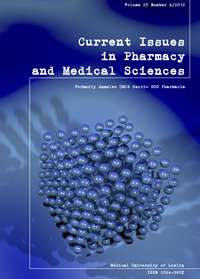Selected markers of bone turnover in type 2 diabetic patients
DOI:
https://doi.org/10.12923/j.2084-980X/25.4/a.05Keywords:
type 2 diabetes, bone turnover, bone markers, osteocalcin, CTxAbstract
The mechanisms of bone alterations in diabetes mellitus type 2 (DM2) are complex and still poorly understood. It depends on the number of protective factors on bone health, such as hyperinsulinemia, obesity, estrogens as well as factors accelerating bone resorption (e.g. hyperglycemia). The aim of this study was to evaluate the concentrations of CTx (C-terminal cross-linked telopeptide of the alpha chain of type I collagen) and OCN (osteocalcin) in DM2 patients and to look for correlations between these markers and selected clinical data as well as biochemical parameters evaluated in routine diagnostics and monitoring of diabetes (glucose, lipid profile, urea, creatinine, parathyroid hormone, HbA1c, ALT, AST and alkaline phosphatase). The study was conducted in 45 patients with type 2 diabetes aged 60.7±10.3 years. The control group consisted of 25 healthy subjects aged 57.6±11.9 years. In DM2 patients the concentrations of OCN (14.5±8.8 ng/ml; p<0.001), CTx (0.3±0.2 ng/ml; p<0.05) were significantly lower than in healthy subjects (28.1±11.9 ng/ml, 0.5±0.2 ng/ml for OCN and CTx, respectively). Significantly higher levels of OCN (p<0.05) and CTx (p<0.01) were found in women than in men within the study group. In DM2 patients OCN concentration was positive correlated with CTx (r=0.721, p=0.000), PTH (r=0.426, p=0.003) and negative with TG (r=-0.349, p=0.019). Furthermore, CTx was directly correlated with ALP (r=0.396, p=0.009) and PTH (r=0.413, p=0.005) as well as inversely with TG (r=-0.302, p=0.044) and HbA1c (r=-0.349, p=0.019). In conclusion, the observed lower levels of OCN and CTx and their positive inter-correlation may suggest overall slowed down bone metabolism with reduced bone formation and bone resorption in patients with DM2.
References
1. Achemlal L. et al.: Bone metabolism in male patients with type 2 diabetes. Clin. Rheumatol., 24, 493, 2005.
2. Akin O. et al.: Evaluation of bone turnover in postmenopausal patients with type 2 diabetes mellitus using biochemical markers and bone mineral density measurements. Gynecol. Endocrinol., 17(1), 19, 2003.
3. Bonds D.E. et al. Risk of fracture in women with type 2 diabetes: the Women’s Health Initiative Observational Study. J. Clin. Endocrinol. Metab., 91, 3404, 2006.
4. Capoglu I. et al.: Bone turnover markers in patients with type 2 diabetes and their correlation with glycosylated haemoglobin levels. J. Int. Med. Res., 36, 1392, 2008.
5. DeFronzo R.A: Pathogenesis of type 2 diabetes mellitus. Med. Clin. N. Am., 88, 787, 2004.
6. De Laet C. et al.: Body mass index as a predictor of fracture risk: a meta-analysis. Osteop. Int., 16, 1330, 2005.
7. Dennison E.M. et al.: Type 2 diabetes mellitus is associated with increased axial bone density in men and woman from the Hertfordshire Cohort Study: evidence for an indirect effect of insulin resistance? Diabetologia, 47, 1963, 2004.
8. Friedewald W.T., Levy R.I., Fredrickson D.S.: Estimation of the concentration of low-density lipoprotein cholesterol in plasma, without use of the preparative ultracentrifuge. Clin. Chem., 18, 499, 1972.
9. Hadjidakis D.J., Androulakis I.I.: Bone remodeling. Ann. N.Y. Acad. Sci., 1092, 385, 2006.
10. Leidig-Bruckner G., Ziegler R.: Diabetes mellitus a risk for osteoporosis? Exp. Clin. Endocrinol. Diabetes, 109(2), 493, 2001.
11. McCarthy A.D., Etcheverry S.B., Cortizo A.M.: Effect of advanced glycation endproducts on the secretion of insulin-like growth factor-I and its binding proteins: role in osteoblast development. Acta Diabetol., 38, 113, 2001.
12. Mooradian A.D.: Dyslipidemia in type 2 diabetes mellitus. Nat. Clin. Pract. Endocrinol. Metab., 5(3), 150, 2009.
13. Okazaki R. et al.: Metabolic improvement of poorly controlled noninsulin-dependent diabetes mellitus decreases bone turnover. J. Clin. Endocrinol. Metab., 82, 2915, 1997.
14. Oz S.G. et al.: Evaluation bone metabolism and bone mass in patients with type 2 diabetes mellitus. J. Natl. Med. Assoc., 98, 1598, 2006.
15. Parhami F., Garfinkel A., Demer L.L.: Role of lipids in osteoporosis. Arterio. Thromb. Vasc. Biol., 20(11), 2346, 2000.
16. Reid I.R.: Relationships between fat and bone. Osteoporos Int., 19, 595, 2008.
17. Revilla M. et al.: Influence of body mass index on the age-related slope of total and regional bone mineral content. Calcif. Tissue Int., 61, 134, 1997.
18. Srivastava A.K. et al.: Clinical use of serum and urine bone markers in management of osteoporosis. Curr. Med. Res. Opin., 21, 1015, 2005.
19. Steyn N.P. et al.: Diet, nutrition and the prevention of type 2 diabetes. Public Health Nutr, 7(1A), 147, 2004.
20. Suzuki K. et al.: Osteoclastic function is accelerated in male patients with type 2 diabetes mellitus: the preventive role of osteoclastogenesis inhibitory factor/osteoprotegerin (OCIF/OPG) on the decrease of bone mineral density. Diab. Res. Clin. Pract., 68, 117, 2005.
21. Thrailkill K.M. et al.: Is insulin an anabolic agent in bone? Dissecting the diabetic bone for clues. Am. J. Physiol. Endocrinol. Metab., 289, 735, 2005.
22. Trznadel-Morawska I. et al.: Przydatność markerów obrotu kostnego w dynamice zmian kostnych w zespole stopy cukrzycowej. Diabetol. Prakt., 9(2), 63, 2008.
23. Vashishth D. et al.: Influence of nonenzymatic glycation on biochemical properties of cortical bone. Bone, 28, 195, 2001.
24. Vestergaard P.: Bone metabolism in type 2 diabetes and role of thiazolidinediones. Curr. Opin. Endocrinol. Diabetes Obes., 16, 125, 2009.
25. Wang X. et al.: Age-related changes in the collagen network and toughness of bone. Bone, 31(1), 1, 2002. 15
26. World Health Organization: Physical status: the use and interpretation of anthropometry. Report of a WHO Expert Committee. World Health Organ Tech. Rep. Ser., 854, 1, 1995.
27. Yamamoto M. et al.: Decreased PTH levels accompanied by low bone formation are associated with vertebral fractures in postmenopausal women with type 2 diabetes. J. Clin. Endocrinol. Metab., 97(4), 1277, 2012.
28. Yendt E.R. et al.: Reduced creatinine clearance in primary osteoporosis in women. J. Bone Miner. Res.
Downloads
Published
Issue
Section
License
Copyright (c) 2012 Authors

This work is licensed under a Creative Commons Attribution-NonCommercial-NoDerivatives 3.0 Unported License.


